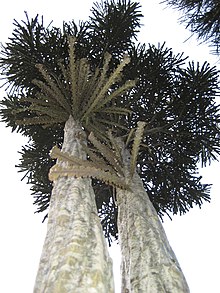
Prumnopitys taxifolia, the mataī or black pine, is an endemic New Zealand coniferous tree that grows on the North Island and South Island. It also occurs on Stewart Island / Rakiura but is uncommon there.

Pseudopanax is a small genus of 7 species of evergreen plants which are endemic to New Zealand. Flowers of the genus occur in terminal umbels.
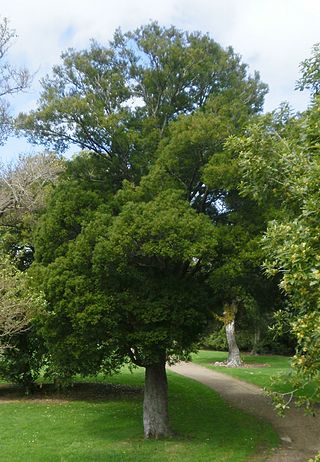
Prumnopitys ferruginea, commonly called miro, is an evergreen coniferous tree which is endemic to New Zealand. Before the genus Prumnopitys was distinguished, it was treated in the related genus Podocarpus as Podocarpus ferrugineus.
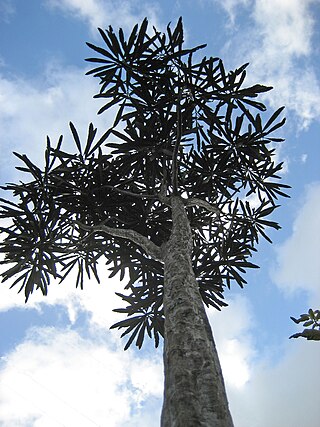
Pseudopanax crassifolius, also known as horoeka or lancewood, is a heteroblastic tree belonging to the family Araliaceae. It is endemic to New Zealand and found throughout the country from sea level up to about 750 m in lowland to montane shrublands and forests.

Brachychiton rupestris is a tree in the family Malvaceae, endemic to Queensland, Australia. Described by Sir Thomas Mitchell and John Lindley in 1848, it earned its name from its bulbous trunk, which can be up to 3.5 metres (11 ft) in diameter at breast height (DBH). Reaching around 10–25 m (33–82 ft) high, the Queensland bottle tree is deciduous, losing its leaves seasonally, between September and December. The leaves are simple or divided, with one or more narrow leaf blades up to 11 centimetres (4 in) long and 2 cm (0.8 in) wide. Cream-coloured flowers appear from September to November, and are followed by woody, boat-shaped follicles that ripen from November to May. No subspecies are recognised.

Araucaria columnaris, the coral reef araucaria, Cook pine, New Caledonia pine, Cook araucaria, or columnar araucaria, is a species of conifer in the family Araucariaceae.

Symplocos stawellii, or the white hazelwood, is a rainforest tree growing in eastern Australia. It often grows along creeks in gullies, in tropical and sub-tropical rainforests. The natural distribution is from Gerringong Creek in the upper Kangaroo Valley of New South Wales to the Atherton Tableland in tropical Queensland. It also occurs in New Guinea.

Pseudopanax colensoi, commonly known as the mountain fivefinger in English and orihou in Māori, is an endemic species to New Zealand. It is a shrub that can often grow into a small canopy tree, and is found in high altitude environments in its preferred areas around New Zealand. It is a member of the Neopanax clade, and is referred to by some sources as Neopanax colensoi.
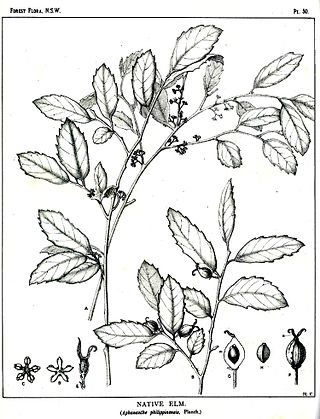
Aphananthe philippinensis is a common rainforest tree in the family Cannabaceae. In Australia it occurs from the Manning River in New South Wales to near Herberton in tropical Queensland. It was first described from the island of Luzon in the Philippines, hence the species name. The generic name of Aphananthe refers to 'insignificant flowers'. This plant also occurs on the Solomon Islands and in Papua New Guinea
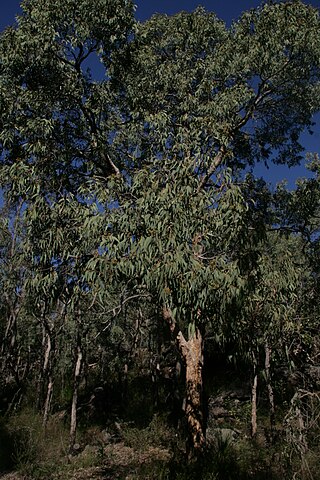
Corymbia eximia, commonly known as yellow bloodwood, is a bloodwood native to New South Wales. It occurs around the Sydney Basin often in high rainfall areas on shallow sandstone soils on plateaux or escarpments, in fire prone areas. Growing as a gnarled tree to 20 m (66 ft), it is recognisable by its distinctive yellow-brown tessellated bark. The greyish green leaves are thick and veiny, and lanceolate spear- or sickle-shaped. The cream flowerheads grow in panicles in groups of seven and appear in spring. Known for many years as Eucalyptus eximia, the yellow bloodwood was transferred into the new genus Corymbia in 1995 when it was erected by Ken Hill and Lawrie Johnson. It is still seen under the earlier name in some works.

Denhamia silvestris is a shrub or small tree growing from Picton, New South Wales to Kroombit Tops, near Gladstone, Queensland. It occurs in dry rainforest, eucalyptus and rainforest ecotone areas. Common names include narrow leaved orangebark, orange bush and orange bark.

Drypetes deplanchei is a tree of eastern and northern Australia. It also occurs in New Caledonia and Lord Howe Island. The genus is derived from the Greek, dryppa meaning "olive fruit". The species named after Dr. Emile Deplanche, who collected this plant at New Caledonia. Common names include yellow tulip, grey boxwood, white myrtle, grey bark and yellow tulipwood.

Mischocarpus pyriformis, known as the pear fruited tamarind is a rainforest tree of eastern Australia. Occurring from Seal Rocks, New South Wales to as far north as Cooktown in tropical Queensland. The sub species found in New South Wales is Mischocarpus pyriformis subsp. pyriformis.

Carpodetus serratus is an evergreen tree with small ovate or round, mottled leaves with a toothy margin, and young twigs grow zig-zag, and fragrant white flowers in 5 cm panicles and later black chewy berries. It is an endemic of New Zealand. Its most common name is putaputāwētā which means many wētā emerge - referring to the nocturnal Orthoptera that live in holes in the trunk of this tree made by Pūriri moth caterpillars. Regional variations on the name also refer to this insect that lives and feeds on it such as kaiwētā, and punawētā. The tree is also sometimes called marbleleaf. It is found in broadleaf forest in both North, South and Stewart Islands. It flowers between November and March, and fruits are ripe from January to February.
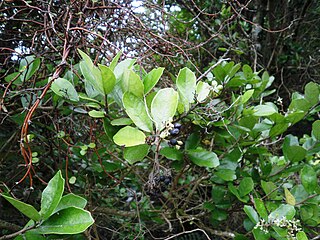
Pennantia corymbosa, commonly known as kaikomako, is a small dioecious tree endemic to New Zealand.
Eucalyptus moderata, also known as redwood mallee, is a species of tree or a mallee that is endemic to the southwest of Western Australia. It has rough, hard, fibrous bark on some or all of the trunk, lance-shaped adult leaves, flower buds usually in groups of seven, pale yellow flowers and pendulous, urn-shaped fruit.

Acacia shirleyi, known colloquially as lancewood, is a species of Acacia native to Queensland and the Northern Territory in Australia. It grows as a tree to 15 metres (49 ft) high, with dark grey or black stringy bark and blue-grey foliage. The yellow flowers appear from March to July. It grows in dry scrub, open forest or mixed savannah woodland. Indigenous people used the wood as fuel and to make hunting spears. Cattle can eat the foliage as fodder.

Holoptelea integrifolia, the Indian elm or jungle cork tree, is a species of tree in the family Ulmaceae, and a close relative to the true elms (Ulmus). It is native to most of Indian subcontinent, Indo-China and Myanmar. It is found mostly on plains but also in mountains on elevations up to 1100 m.
